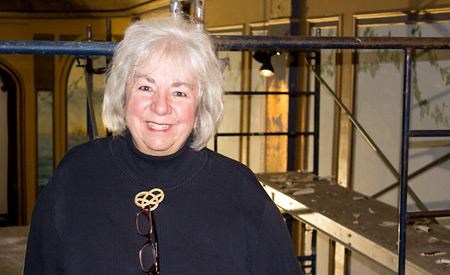After six weeks of stripping out sodden materials from Patricia Theatre, work has started on repairing its ceiling, floors and walls.
Co-owner and repairs project coordinator Ann Nelson said that up until now they have not been able to set out a timeline for the theatre’s reopening.
“They couldn’t define the scope of project until everything had been removed,” Nelson said.
The theatre is working toward a grand re-opening near the end of November. The first film shown will be the latest Hunger Games: Mockingjay, Part 1 of the last book in the trilogy by Suzanne Collins.
Typically the end of November is the start of Hollywood’s blockbuster season, a key time for theatres to make enough money to take them through the lean winter and spring months, she said.
The auditorium’s 300 seats and carpet have been removed. Scaffolding has been set up to complete the restoration, which includes repainting the ceiling completing its sky mural. Eight seats were damaged from the water and a number have had to have their springs replaced.
The project repairs are covered by insurance, but Nelson said she has had to continue paying the theatre’s overhead despite being closed, a period she estimates will be about 12 to 14 weeks in total.
On August 29 hundreds of gallons of water sprayed into the theatre’s attic after one of its 40 sprinkler heads failed catastrophically sending a torrent of water across the 86-year-old bone-dry wooden lath which holds its plaster ceiling up. Water flowed down stairwells, ruining carpet and damaging seats, wall murals and wallpaper as it ran through to the floor.
Restoration workers removed the theatre’s acoustic panels, wallpaper and sodden Donnacona board. They cut a hole in the ceiling to remove the nearly four tonnes of soaked insulation and placed fans and dehumidifiers in the attic to remove any remaining moisture.
No cause for why the sprinkler failed has been established, said Nelson.
The sprinkler which failed is located in the attic over the balcony on the side closest to the concession. It took three days for the water to stop draining from the ceiling, she added.
“It passed its annual inspection, but so had the other 39 up there,” she said.
Fire suppression sprinkler heads have a 50-year lifespan and the ones in the attic had been replaced in 1979.
The experience has left Nelson with questioning the integrity of the remaining attic sprinklers, so much so that once the repairs are completed she is planning on organizing community fundraising events to replace them.
If there is a silver lining to the silver screen disaster it lies in the fact that the project has been somewhat of “an archaeological exploration” of the heritage building, she said. As wall materials were taken down, Nelson discovered a number of faux wall finishes and stenciled designs. She also discovered the original colour scheme for the theatre which included shades of light and dark tobacco brown and indigo blue, something that had only been hinted at in old black and white photographs.
“The insurance company has been really great letting me take over the sourcing of tradespeople that I want to work with and the materials,” said Nelson. She was able to bring in a company who she has worked with previously on theatre repairs.
Also, the artist who painted the wall murals almost 15 years ago has agreed to return to repair the water damage to them and finish the ceiling mural.
An acoustic engineer will help to source materials to replace the Donnacona board and retune the audio system to its new walls.
The auditorium’s floor boards are being repainted and sealed and new carpet will be laid throughout. The concession’s carpet is being replaced with a linoleum to make it easier to keep clean.
“Gravity is going to draw all the water through everything as it tries to find its final level,” she said. “In a building like this, there is no worse place for there to be a catastrophic failure than the attic.”



